Libby Fischer Hellmann's Blog, page 17
June 15, 2016
How to Produce an Audiobook in 7 Steps
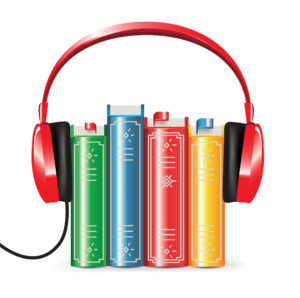 The Audible website hosts more than 200,000 audiobooks, and more readers listen to audiobooks than ever before. If you’re a writer who’s just starting to think about converting your work to audio, here’s an overview based on working with ACX, Audible’s platform for audiobook production. It’s open to all authors, indie and traditional, as well as small publishers, as long as you have the rights to your work. I’ve done most of my 17 audiobooks through their auspices, and while there are other options out there, I think ACX is pretty amazing. Of course, you may be lucky enough to have an audiobook publisher do the whole thing for you. If so, this post is not for you. But if you’re not one of the lucky ones, keep reading.
The Audible website hosts more than 200,000 audiobooks, and more readers listen to audiobooks than ever before. If you’re a writer who’s just starting to think about converting your work to audio, here’s an overview based on working with ACX, Audible’s platform for audiobook production. It’s open to all authors, indie and traditional, as well as small publishers, as long as you have the rights to your work. I’ve done most of my 17 audiobooks through their auspices, and while there are other options out there, I think ACX is pretty amazing. Of course, you may be lucky enough to have an audiobook publisher do the whole thing for you. If so, this post is not for you. But if you’re not one of the lucky ones, keep reading.
1. Decide how you’re going to pay and whether you’ll be exclusive – Producing an audiobook is not cheap (about $3000), but there is a way through which you do not need to pay anything up front when you’re working with ACX. Basically, they offer three options, the first of which is helpful when you don’t happen to have 3K lying around.
Royalty Share: This is just what it means. The rights holder (that’s you, the writer) will share royalties with your narrator/producer. If you’re exclusive to ACX, you’ll each get 20% of the royalties – without you having to pay anything up front. Some narrators do not want this arrangement for obvious reasons (they don’t get a fee up front), but others, particularly beginning narrators, do. ACX sometimes offers stipends to the narrator, though, if they think the audiobook has potential, so there’s a chance the narrator will get something. This is the option that is least attractive—at least to me— since I’m splitting my 40% royalty with my talent. But I have used it, particularly when I first got started.
Pay for Production with a 25% Royalty. If you have the money pay for it yourself. That’s how you get the best royalty percentage. If you are non-exclusive with ACX, you’ll get 25% royalty, (which isn’t a whole lot) but is better than 20%.
Pay for Production with a 40% Royalty: If you distribute exclusively through ACX, which means your audiobook will be sold on Audible, Amazon, and iTunes, you can pay for the production yourself and get a 40% royalty. This is the option I recommend, since the three vendors mentioned probably sell 75-80% of all audiobooks in the US anyway. When I’m flush, that’s the option I use.
 2. Choose a narrator– This is probably the most important decision you’ll make, since the voice you give your book is what brings it to life. Do you want a male or female voice? More than one? (It will be more expensive). You’ll want someone who reads a bit slower rather than faster since a high speed read makes it difficult for listeners to distinguish between dialogue and descriptive text. And if it’s too slow, you can always speed up the narration in post-production. You need a natural voice, not someone who sounds like a cartoon character, since silly voices are distracting. Most of all, look for someone who breathes life into every sentence, not just the dialogue or description. A truly great narrator is basically an actor who can make even the most banal sentence sound appealing.
2. Choose a narrator– This is probably the most important decision you’ll make, since the voice you give your book is what brings it to life. Do you want a male or female voice? More than one? (It will be more expensive). You’ll want someone who reads a bit slower rather than faster since a high speed read makes it difficult for listeners to distinguish between dialogue and descriptive text. And if it’s too slow, you can always speed up the narration in post-production. You need a natural voice, not someone who sounds like a cartoon character, since silly voices are distracting. Most of all, look for someone who breathes life into every sentence, not just the dialogue or description. A truly great narrator is basically an actor who can make even the most banal sentence sound appealing.
Happily, ACX has an audiobook exchange where you can listen to tons of voices whenever you want, and then whittle down your choices. I suggest that you go with someone who has already voiced an audio. They should know the production process from A to Z, and may include post production and mastering in their fee. You can also ask fans whom they like as narrators. Naturally, the more popular ones will have a higher hourly.
Let’s talk about fees. It isn’t cheap to produce an audiobook. Plan to spend at least $3000 for the production; most of it goes to the narrator, the rest will be spent on your engineer (see below) and promotion. Sure, you can do it for less, if you have a friend who’s a professional. Bear in mind that many narrators quote on what’s called “Per Finished Hour” basis, meaning that they’ll take care of the Post-production and Mastering as well as the narration.
One other thought: If you’re not a professional, I don’t recommend you voice the audiobook yourself. It’s much harder than it sounds. I am happy hosting interviews and podcasts, but I would NEVER voice my own audiobook.
 3. Post-Production and Mastering
3. Post-Production and Mastering
This is the step many beginners don’t know about, but it’s hugely important. In addition to the narrator, you’re going to need an audio engineer to polish the recording. Although the narrator is responsible for their voice, there are certain technical requirements for an audiobook. For example, Audible has a rule for how many seconds there should be between the end of a chapter and the end of the recording of that chapter, and how the audiobook should be introduced and concluded. You’ll also need to ensure that the volume and pacing are consistent throughout, and any “noise” on the recording (clicks, long breaths, or other errors are eliminated.
If you hire an experienced narrator, chances are they will probably have someone they use or they’ll do it themselves. And that cost will be included in their hourly rate. If they don’t, though, you’ll need to find one. Compared to the narrator, they’re not expensive – anywhere from $500 to $1000 is normal.
Only after you’ve auditioned, offered, and contracted with a narrator, and have settled the issue of Mastering, are you ready to go into production.
4. Listen to the chapters as they come in, and make revisions as necessary – Of course there are going to glitches and issues that surface during the recording. A narrator may miss a line, or their inflection isn’t what you wanted. It’s a lot easier on both of you if you agree the narrator will send you, say, 5 chapters at a time. That way you won’t go crazy trying to proof the whole book at once. This does mean that you’ll have to listen to every chapter that’s recorded– it may be the only time you do—so it’s important. The narrator will upload chapters to ACX and you can listen online or download them to your computer.
Each chapter will have a “time code” – that indicates where you are in minutes and seconds. I highly recommend you use time code when you’re requesting changes. Makes it a LOT easier for you both when you refer to the revision at, say, 5:35 ( 5 minutes, 35 seconds) into Chapter 17.
 5. Mastering, equalizing and uploading – Once all the chapters, intro, and conclusion have been recorded, the audio is ready for post-production and mastering. Post-production is where you need an engineer to listen to the entire production and eliminate long breaths, clicks and other noise that can creep into the audio. Then it will be equalized to make sure the narration and pacing are consistent throughout. The final production will then be “mastered” or formatted into the parts that Audible or other audiobook vendor require (little things like an intro, an outro, or how many seconds there needs to be between chapters.) The engineer/producer will provide you with a final master recording of the digital files formatted for Audible, Once you approve, the narrator will upload the files for quality checks at ACX and Audible. At this point, if you’re paying for production, you need to send the narrator their fee before anything else can happen.
5. Mastering, equalizing and uploading – Once all the chapters, intro, and conclusion have been recorded, the audio is ready for post-production and mastering. Post-production is where you need an engineer to listen to the entire production and eliminate long breaths, clicks and other noise that can creep into the audio. Then it will be equalized to make sure the narration and pacing are consistent throughout. The final production will then be “mastered” or formatted into the parts that Audible or other audiobook vendor require (little things like an intro, an outro, or how many seconds there needs to be between chapters.) The engineer/producer will provide you with a final master recording of the digital files formatted for Audible, Once you approve, the narrator will upload the files for quality checks at ACX and Audible. At this point, if you’re paying for production, you need to send the narrator their fee before anything else can happen.
6. Audiobook cover – The artwork might be the same artwork featured on the cover of your ebook or print version, but condensed into a square format. If you don’t own the cover yourself, you might have to pay extra image licensing fees. The same rules apply as to ebooks – the cover is your primary promotional tool, so it pays to get it right.
7. Market and promote the audiobook – Whatever format your work takes, some things never change. The most important thing of all is the marketing and promotion, including uploading samples to your website and other social media platforms. You will get 25 free download codes for reviewers, and I encourage you to solicit reviews and share copies with influencers. Look up the FB groups or pages that review or focus on audiobooks and make yourself known. Email your fan database with details. You can use your blog to write about the audiobook process itself, the plot, the inspiration… you can even interview the narrator, or get them to interview you on their blog. If you’re going to do Facebook ads, you can now take a few seconds of the track and use it in the ad… I’m experimenting with that now.
I hope the above proves useful… Audio veterans, have I missed anything?
The post How to Produce an Audiobook in 7 Steps appeared first on .
June 9, 2016
Stumped, Crazy and Blue – Battling Writer’s Block
Thanks to Scott Biram for the title…
As the poet, novelist and short story writer Charles Bukowski said, “Writing about a writer’s block is better than not writing at all”. I know what he means. For the first time in years I am uncertain what to write. I’m stumped, stuck in the mud, and blue. I only have about 50 more pages to go in a novella about German POWs, but I’m procrastinating beautifully. Why? After I finish, I’ll have to confront a black hole in my universe.
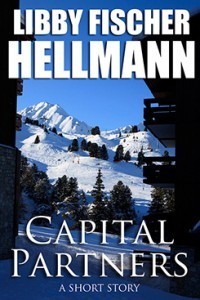
I thought I wanted to write a caper book with 2 women, a happy globe-trotting Thelma and Louise adventure, next. It is actually the sequel to a short story I wrote called Capital Partners. But I’m not feeling passionate about it. So, how do I create the passion? Or do I go back to Georgia Davis and write another PI novel? Or another Ellie Foreman? Help. Im feeling like my feet are stuck in concrete.
So… because Bukowski said it was okay, I thought I’d take a leaf out of his book and explore the causes of and solutions to writer’s block.
What are the causes behind writer’s block?
According to the Goinswriter website, one of the best known causes of writers block is timing, where it simply isn’t the right time to write. In which case the ideas in your head might have to mature for a while longer before they’re ripe enough to bloom. I don’t buy that, however. I am in the school of plant-butt-in-chair-and-write, whether you feel like it or not. Usually.
Sometimes it’s fear, the thought that you’re putting your ideas – which are extensions of yourself – out there for criticism. And perfectionism is the bane of some writers’ lives, a hard taskmaster, impossible to please. That I understand… I feel inadequate most of the time I write.
How to break free
So, how does one break free? An internet search reveals no easy answers, but it also shows that writer’s block is common, which is good to know when it’s easy to fall into the trap of thinking it’s “just me.”
Some say free write, the quirkier, the better. Anne Lamott agrees.
“I encourage my students at times like these to get one page of anything written, three hundred words of memories or dreams or stream of consciousness on how much they hate writing — just for the hell of it, just to keep their fingers from becoming too arthritic, just because they have made a commitment to try to write three hundred words every day. Then, on bad days and weeks, let things go at that… Your unconscious can’t work when you are breathing down its neck. You’ll sit there going, ‘Are you done in there yet, are you done in there yet?’ But it is trying to tell you nicely, ‘Shut up and go away.’”
Others say go for a walk, or a run, or play a game, or listen to music, something to get your blood running and eliminate distractions. A change of environment scores high, as does calling a friend or spending time with people who make you feel good. Brainstorming ideas gets some credit, where the very act of jotting down ideas in bullet points can unblock the writer’s brain.
Reading is another solution. In fact, that used to be my go-to favorite. Often I’ll crack open a book in the middle of writing a manuscript. Any book. Usually by the time I’ve read a few pages, I’m ready to go back to my own work. Maybe it will work now.
So that’s my plan – at least this week. I’ve decided I’m going to read, and maybe that will clear my foggy brain. I’m looking for new-to-me authors. Any recommendations?
The post Stumped, Crazy and Blue – Battling Writer’s Block appeared first on .
June 4, 2016
10 ways to ‘Read’ More Books with Audio
 Audiobook sales are booming. Goodereader says that the global audiobook industry is currently worth 2.8 billion dollars and that approximately 3.88 million audiobooks were downloaded in 2015 compared to 2.47 million ebooks. Indeed, audiobooks are the fastest-growing distribution method in publishing today. I won’t go into all the reasons–you probably already know them–but I will mention a few:
Audiobook sales are booming. Goodereader says that the global audiobook industry is currently worth 2.8 billion dollars and that approximately 3.88 million audiobooks were downloaded in 2015 compared to 2.47 million ebooks. Indeed, audiobooks are the fastest-growing distribution method in publishing today. I won’t go into all the reasons–you probably already know them–but I will mention a few:
— They’re convenient. With ebooks and physical printed books you have to sit down and concentrate. Drop your Kindle in the bath and you’ll wreck it. With audiobooks you can multi-task and go hands-free (most of the time).
— It’s a terrific way to “squeeze in” an extra book between the others.
— And most important: who doesn’t like to have a story told to them? It can be an entirely different experience from reading words on a page. Even I have succumbed. Probably 50% of the “books” I read now are on audio; the other 50% are split between ebooks and print.
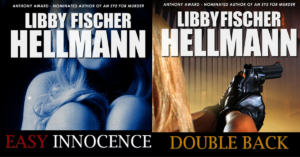 All 13 of my thrillers, including my short story collection, are on audio and available at Audible, Amazon, and iTunes. In fact, I am in the process of RE-recording several of my audiobooks. Easy Innocence with Beth Richmond as narrator, and Doubleback, with Eva Kaminsky are already done, and I do have a few codes if you’re interested in a free download in exchange for a review. (Email me through my website).
All 13 of my thrillers, including my short story collection, are on audio and available at Audible, Amazon, and iTunes. In fact, I am in the process of RE-recording several of my audiobooks. Easy Innocence with Beth Richmond as narrator, and Doubleback, with Eva Kaminsky are already done, and I do have a few codes if you’re interested in a free download in exchange for a review. (Email me through my website).
It’s not that they weren’t professionally done in the first place, but as a now-avid customer of audiobooks myself, I understand better how the right narrator can add nuance, clarity, and enjoyment to an audiobook. They can make the difference between a good book and a great one.
Did I mention how convenient they are? Let me count the ways.
10 ways to listen to books throughout the day

1. In the pool: Really. I just bought this amazing little contraption. (a tiny waterproof iPod) It works! Now I swim laps by time instead of counting them. And get in a few chapters while I’m at it.
2. On my daily walk, elliptical, or other exercise
3. While I’m doing your hair and makeup, or shaving for the guys
4. During my commute, whether by car, bus, airplane or tram
5. While preparing dinner, doing the dishes, or cleaning the house
6. Driving around doing errands
 7. In the park
7. In the park
8. At work – some jobs mean you can free part of your brain to enjoy stories while the rest of you focuses on getting your work done. If your job is monotonous it can be a sanity-saver
9. While waiting in line for tickets, service, a doctor’s appointment, an elevator, a decision.
10. In bed, at the end of the day, when you like nothing better than drifting off to a great story
What about you?
Have you joined the audiobook brigade yet? Where and when do you listen?
Next time I’ll talk about the production process.
The post 10 ways to ‘Read’ More Books with Audio appeared first on .
May 26, 2016
Co-Authoring – The Latest Trend
Co-authoring with prominent authors or their estates (when they’re no longer with us) is a fast-growing trend for crime authors. Many are following the James Patterson model, who released 15 novels in 2014 alone.
“23 other authors have been paid out of Patterson’s own pocket to write them for him. It is not a fact he hides: every novel that is written by somebody else declares so on the cover, under Patterson’s name. Patterson is responsible for the vision and plotline of each novel and series and will give a detailed outline to the hired writer in question. The co-author, some of whom are struggling, others bestsellers in their own right – such as Swedish author Liza Markland – will then draft the early chapters. Patterson will read, revise and demand new drafts until he is satisfied.”
But he’s not the only author to “collaborate.” Ace Atkins and Reed Farrell Coleman are writing Robert Parker books. Although Parker died in 2010, Boston PI Spenser and Jesse Stone, the police chief in Paradise, live on. In fact, both Ace Atkins’s third Spenser novel Cheap Shot, and Reed’s first Jesse Stone novel Blind Spot, shot up the bestsellers lists, and they were contracted to write more.
When asked about the challenges of writing as Parker, both authors talked to Mystery Scene Magazine about the process.
According to Atkins, “The expectations of fans and the high quality of Bob’s work. After all, he was a true master. As a longtime fan, you try not to think whose running shoes you’re trying on. To paraphrase what Spenser says to Sixkill in Bob’s last novel, just do the job you’ve been training to do. I’m now on my 16th novel and the fourth Spenser.”
Coleman said: “It’s a bit of a high wire act to take over a successful series from anyone, but especially from one of the most gifted, well-loved, well-respected authors in the genre’s history. The greatest challenge for me was not to focus on whose shoes I was trying to fill and to approach Blind Spot the way I would approach any of my other projects. That is to say, to write the best book I could write.”
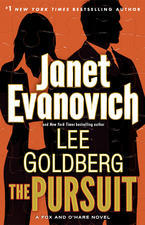 Janet Evanovich and Lee Goldberg share almost equal bylines. The two writers co-authored the Fox and O’Hare adventure/caper novels, creating The Heist, The Chase, The Job, The Scam, The Pursuit (out in June ) and a couple of E-shorts. Janet has also co-authored “Knight and Moon” adventures with Phoef Sutton, as well as a series of romances with Charlotte Hughes, Leanne Banks, and Dorien Kelly.
Janet Evanovich and Lee Goldberg share almost equal bylines. The two writers co-authored the Fox and O’Hare adventure/caper novels, creating The Heist, The Chase, The Job, The Scam, The Pursuit (out in June ) and a couple of E-shorts. Janet has also co-authored “Knight and Moon” adventures with Phoef Sutton, as well as a series of romances with Charlotte Hughes, Leanne Banks, and Dorien Kelly.
Crime thriller author Joel Goldman and Lisa Klink are at it, too. 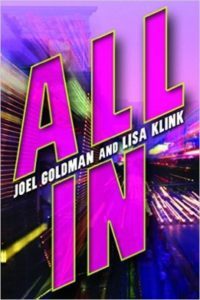 Joel is the bestselling author of the Lou Mason, Jack Davis, and Alex Stone thrillers. Lisa Klink comes from the world of Star Trek, writing for Deep Space Nine and Voyager before moving on to Martial Law and Missing. The novel All In is the result.
Joel is the bestselling author of the Lou Mason, Jack Davis, and Alex Stone thrillers. Lisa Klink comes from the world of Star Trek, writing for Deep Space Nine and Voyager before moving on to Martial Law and Missing. The novel All In is the result.
JT Ellison and Catherine Coulter co-author novels, and in early 2011 thriller author Jamie Freveletti was approached by the estate of Robert Ludlum to write the next in the Covert One series. Called The Janus Reprisal, it came out in 2012, followed by another, 2015’s The Geneva Strategy. In her characteristically modest way, she said
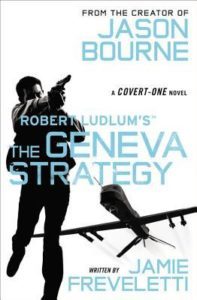 “It was a high-pressure task. I tried to act cool, but inside I was thinking constantly about the Ludlum novels that I’d read. Would I be able to come close to his fast paced and engrossing writing style? Was I crazy to accept? And if I did accept and wrote the book, would the fans embrace me?”
“It was a high-pressure task. I tried to act cool, but inside I was thinking constantly about the Ludlum novels that I’d read. Would I be able to come close to his fast paced and engrossing writing style? Was I crazy to accept? And if I did accept and wrote the book, would the fans embrace me?”
Tie-Ins, Too
Even best-seller Jeffrey Deaver got into the act by writing a new Bond story with the James Bond estate. Over 100 million Bond books have been sold and more than 50% of the entire planet’s population has seen a Bond film. Ian Fleming himself only wrote 14 James Bond books, but official James Bond novels have been written by Kingsley Amis, John Gardner, Raymond Benson, Sebastian Faulks, and William Boyd.
Through Lee and Raymond I discovered there is a special association for “Tie-In” writers, who “novelize” movies, continue a series, or otherwise extend the life of a well known brand.
The pros and cons of co-authorship
On the plus side, there’s good money, sometimes great money. Of course, I’m not privy to the contractual side of things, but I assume each contract is different. Some co-authors may get royalties, while the others have a work-for-hire arrangement. It’s also an excellent opportunity for midlist authors to get their work in front of huge audiences and thus boost their brand.
On the down side, collaborative writing takes a certain personality, someone willing and able to let go of their own style and adopt or merge with another’s. There’s also the matter of creative conflict between the authors, or misunderstandings between the co-author and the primary author’s estate. Consistency might prove a tricky issue – it can be tough matching the author’s writing AND working style with flair, confidence and success. There can be criticism from fans who are not fond of novels that imitate others, and it might be a bridge too far for writers with an independent spirit or don’t enjoy compromise.
All told, though, it’s an excellent way for an author to advance their career. And it seems to be a trend that’s lasting.
What’s the best co-authored novel you’ve read?
Have you read a co-authored book that was totally convincing? Maybe you’ve read one that didn’t work for you. Either way, I’d love to hear about them.
The post Co-Authoring – The Latest Trend appeared first on .
May 22, 2016
Biographies, Autobiographies and Ghostwriters
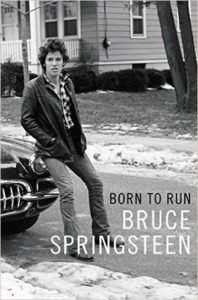 Bruce Springsteen’s autobiography is due out in September 2016. Fans of The Boss can’t wait for the release of Born to Run on September 27th. It’s fully expected to be an international bestseller, and the rights have already been sold all over the planet. Simon and Schuster should score a massive hit. But what makes a great autobiography?
Bruce Springsteen’s autobiography is due out in September 2016. Fans of The Boss can’t wait for the release of Born to Run on September 27th. It’s fully expected to be an international bestseller, and the rights have already been sold all over the planet. Simon and Schuster should score a massive hit. But what makes a great autobiography?
Springsteen has been working on his highly personal memoir for seven years, kicking the book off after the famous sell-out Super Bowl halftime with the E Street Band in 2009.
As he says in WritersWrite,
“Writing about yourself is a funny business. But in a project like this, the writer has made one promise, to show the reader his mind. In these pages, I’ve tried to do this.”
You can expect an exploration of The Boss’s early years and his steely determination to make it. Plus insights into the creative sprit that drives the man, who is, as he says, fueled by, “poetry, danger, and darkness.” By all accounts the book lives up to its promise, rich in detail and delving deep into the man’s motivation, struggles, dark times, and successes. Perhaps that’s what makes a great autobiography: the personal touch, the authenticity you don’t get from a story told second-hand.
So then, if that’s the case, what makes a great biography? Probably the same elements as an autobiography: the reader’s ability to recognize the subject’s strengths, weaknesses, and essential humanity, even though it’s written by a third party.
The biographers I rate highest
I’ll read everything the multi-award winning Doris Kearns Goodwin writes. Douglas Brinkley too. Why is that?
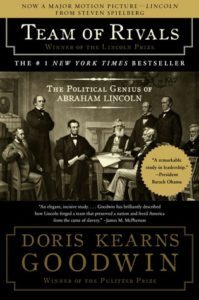 Kearns is a biographer, historian, and political commentator. She’s written bios of several US presidents, including Lyndon Johnson, and the Fitzgeralds (of the Kennedy clan). She’s brought Franklin and Eleanor Roosevelt to sparkling life, portrayed Abraham Lincoln in her blockbuster Team of Rivals and, most recently, explored Theodore Roosevelt, William Howard Taft, and the Golden Age of Journalism. It’s intelligent, perceptive, finely-detailed work, and as a reader you get a real sense of discovery, thanks to her research. These are not exercises in flattery. They’re merciless. You get a real sense of the personalities she dissects, warts and all. And, of course, she writes like a dream.
Kearns is a biographer, historian, and political commentator. She’s written bios of several US presidents, including Lyndon Johnson, and the Fitzgeralds (of the Kennedy clan). She’s brought Franklin and Eleanor Roosevelt to sparkling life, portrayed Abraham Lincoln in her blockbuster Team of Rivals and, most recently, explored Theodore Roosevelt, William Howard Taft, and the Golden Age of Journalism. It’s intelligent, perceptive, finely-detailed work, and as a reader you get a real sense of discovery, thanks to her research. These are not exercises in flattery. They’re merciless. You get a real sense of the personalities she dissects, warts and all. And, of course, she writes like a dream.
Douglas Brinkley, according to Stephen Ambrose, his university mentor, is, “the best of the new generation of American historians.” His 2012 bio of Walter Cronkite won the 2013 Ann M. Sperber Biography Award for 2013. His 1992 bio of James Forrestal won the Theodore and Franklin Roosevelt Naval History Prize. And his biographies of Dean Acheson, FDR, Jimmy Carter, Henry Ford, John Kerry, and more have been received with considerable critical acclaim.
What makes a bad bio/autobiography?
Is it research? A lazy biographer might skip the deep stuff, or avoid things that might embarrass the subject, or be too over-awed by their fame to reveal the real personality beneath the glitz. They might be tempted to gloss over the less positive aspects of a life, creating a story that’s long on flattery and short on fact. An autographical book might cover up incidents they’re ashamed of, bored by, or would rather forget. Or the subject might simply be a terrible writer. Just because they’re famous doesn’t mean they can string a worthwhile sentence together, construct a believable timeline, or weave a convincing plot.
The Friendly Ghostwriter
Which brings us to the ghostwriter. Search Google and there are loads of websites where you can find a ghostwriter for your book, bio or not. In a way it resembles vanity publishing. All you need is an idea. Someone else brings it to fruition, and you take all the credit.
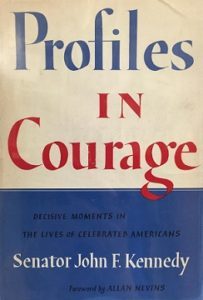 Some see it as cheating. Others wouldn’t publish without one. In the final analysis, however, if it’s a great story, does it really matter? Self-styled digital marketing guru Guy Kawasaki admits using ghostwriters for his Twitter account, and the world keeps turning. Early drafts of mega-sellers like Profiles in Courage by JFK were written by Ted Sorenson, and even Anne Frank’s Diary of a Young Girl was heavily “edited” by her father.
Some see it as cheating. Others wouldn’t publish without one. In the final analysis, however, if it’s a great story, does it really matter? Self-styled digital marketing guru Guy Kawasaki admits using ghostwriters for his Twitter account, and the world keeps turning. Early drafts of mega-sellers like Profiles in Courage by JFK were written by Ted Sorenson, and even Anne Frank’s Diary of a Young Girl was heavily “edited” by her father.
If you use a ghostwriter, it might improve the chances of your book getting published. It frees you to concentrate on promoting the book. And the ghostwriter might be skilled enough so nobody notices. The best ghosts are, by nature, good listeners, able to separate the wheat from the chaff. And, as many of us know, writing is rarely fun. It’s incredibly hard work, especially if you have brilliant ideas but don’t have the right temperament to write yourself.
Still, using a ghostwriter doesn’t guarantee success. Goodreads provides a list of the worst celebrity tomes, including The Real Patsy Cline by Doug Hall, a bio of Sylivia Plath by Linda Wagner-Smith, Marilyn Monroe by Barbara Learning and Ivan the Terrible by Isabela de Madariaga.
Next week, I’ll talk about “co-authoring,” which, the latest trend in fiction writing.
The post Biographies, Autobiographies and Ghostwriters appeared first on .
May 5, 2016
Why I’m Writing My Way around the Genre
Some readers read mainly one genre. Romance, for example. Or historicals. Or Sci-fi. The genres include many variations on a theme, but, generally, each novel is similar to the next. Which can be comforting. You know what you’re going to get.
I’d like to think the crime fiction genre is different. As a crime thriller writer, it seems to be broader. Yes, a crime is central to the plot, and you can be sure you’re going to deal with the underbelly of human nature. But there are so many different ways in which the crime and the characters involved are revealed, treated, and resolved that it never seems tired. There are many sub-genres within crime fiction, and each has its own conventions. Consider:
Thrillers (Crime, legal, political, medical)
Espionage
Historicals
PI novels
Cozies
Amateur Sleuths
Police Procedurals
Caper Stories
Noir
In fact, the thriller sub-genre, according to James Patterson, is constantly evolving:
“Thrillers provide such a rich literary feast. There are all kinds. The legal thriller, spy thriller, action-adventure thriller, medical thriller, police thriller, romantic thriller, historical thriller, political thriller, religious thriller, high-tech thriller, military thriller. The list goes on and on, with new variations constantly being invented. In fact, this openness to expansion is one of the genre’s most enduring characteristics.
So, instead of churning out 15 novels in the same series, I’ve spent the last 15 years writing my way around the genre.
Why? Several reasons. One, I get bored easily, and variety is the spice of life. Two, I love fresh challenges and the chance to experiment with shades of suspense, characters, settings, plots, endings. Third, I don’t want to run a series into the ground. I want my work to stay fresh. Fourth, as I mentioned before, every subgenre has its own subtle conventions and quirks. I get a kick out of the challenge of learning and applying them to a story.
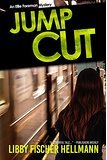 I don’t want to trot out yet another of the same old thing to my readers. Although it may be comforting, I’ve seen too many series dwindle and then just disappear after five or six installments. I’d rather send Ellie Foreman, my amateur sleuth, on vacation for 10 years. Which I did. She only just emerged from “hiatus hell” to anchor JUMP CUT, which came out in March.
I don’t want to trot out yet another of the same old thing to my readers. Although it may be comforting, I’ve seen too many series dwindle and then just disappear after five or six installments. I’d rather send Ellie Foreman, my amateur sleuth, on vacation for 10 years. Which I did. She only just emerged from “hiatus hell” to anchor JUMP CUT, which came out in March.
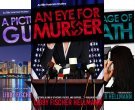 Ellie on the precipice
Ellie on the precipice
Beyond the predictability of a series, there were two reasons I had to stop writing Ellie. The first was her voice. I write Ellie in first person, which I believe is the most intimate voice a writer can use. You really KNOW Ellie inside and out by the time you’ve finished one of her stories. However, as my craft developed and matured, I wanted to explore other characters’ POVs as well, and I found I couldn’t do it as gracefully as I wanted. I did it, primarily in AN IMAGE OF DEATh, but it wasn’t perfect. I needed a third person POV so I could dip into other characters’ thoughts.
The second reason was that Ellie was an amateur sleuth, and by book four I found myself bending over backwards to find a credible reason for her to get involved in a murder investigation. There are only so many bodies a video producer can realistically run across. After that it gets a bit strained and harder to suspend belief. It’s probably due to my former life as a broadcast news person – I want to be as accurate and credible as possible, and Ellie wasn’t making it easy.
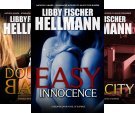 Georgia has more staying power
Georgia has more staying power
Georgia Davis, the protagonist of my four PI novels, solved my dilemma. She’s a powerful character and a popular (my Georgia books actually do better than the Ellie books in terms of sales.) Best of all, it’s her job to investigate murders, so I don’t have to turn backflips to find a reason for her to get involved. After four novels she’s gone through a development ARC, but she’s still fresh with lots of potential. So I’ll be coming back to her at some point. The key is to wait for the right story to showcase Georgia’s circumstances and skills.
More crime thriller sub-genres
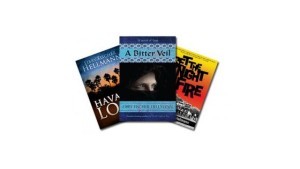 Besides the nine novels in the two series, I’ve written three stand-alone historical thrillers. One is about the late Sixties in the US; another is about the Iranian Revolution; the third begins during the Cuban revolution (sense a theme here?) I’ve also written a cozy novella, and one of the Georgia Davis novels is actually a prequel and occurs when she was still a cop, so it’s a police procedural. I’ve also been sidetracked by World War Two. I’ve written one novella and several short stories that are set then, and am about to finish a second novella about German POWs in the US. My plan is to package them all together later this summer, and I’ve given it the tentative title Homefront. Next up is a caper novel – a “Thelma and Louise” story with a happy ending for a change.
Besides the nine novels in the two series, I’ve written three stand-alone historical thrillers. One is about the late Sixties in the US; another is about the Iranian Revolution; the third begins during the Cuban revolution (sense a theme here?) I’ve also written a cozy novella, and one of the Georgia Davis novels is actually a prequel and occurs when she was still a cop, so it’s a police procedural. I’ve also been sidetracked by World War Two. I’ve written one novella and several short stories that are set then, and am about to finish a second novella about German POWs in the US. My plan is to package them all together later this summer, and I’ve given it the tentative title Homefront. Next up is a caper novel – a “Thelma and Louise” story with a happy ending for a change.
So, while it might make it more difficult to “brand” myself (whatever that really means) I like the freedom to explore and sink myself into new challenges. I think I’ll keep it up.
In the meantime, what sub-genre of crime fiction appeals to you? Why?
The post Why I’m Writing My Way around the Genre appeared first on .
April 23, 2016
I Really Wanted to Like Eye in the Sky
 Last week I saw Eye in the Sky. I really wanted to like it. With Colin Firth producing, Helen Mirren as Colonel Katherine Powell and the late Alan Rickman, in his final movie role, as Lieutenant General Frank Benson, the signs were all good. But it fell a bit short.
Last week I saw Eye in the Sky. I really wanted to like it. With Colin Firth producing, Helen Mirren as Colonel Katherine Powell and the late Alan Rickman, in his final movie role, as Lieutenant General Frank Benson, the signs were all good. But it fell a bit short.
The story goes like this: Colonel Powell (Helen Mirren) wants to order a drone strike to take out a group of terrorists in Nairobi, Kenya. But a young girl selling bread in the kill zone forces those involved to make dire decisions as to “collateral damage.”
The themes of the story are the legal, ethical and political dilemmas presented by drone warfare against those using terrorist tactics and the impact on civilians who are endangered by it, all powerful contemporary themes that go right to the heart of western democracy.
The acting was excellent. And it was a fascinating examination of how far Brits are prepared to go to avoid collateral damage. In fact, most of the film showed the request for the drone strike climbing up the British chain of command, ultimately crossing over to the American Secretary of Defense’s turf. I wasn’t sure we in the US would go to the same lengths, although, to be fair, I met (in a bookstore of all places) a retired US Navy captain who worked around drones , and she disagreed, claiming “the (military’s) concern for collateral damage is extraordinary.”
Still, there was something unsatisfying about the film. Was I alone? As a former film person, I thought it’d be fun to see what reviewers said. Of course, reviews are always subjective, but here we go.
The New York Times says: “It is a grim, suspenseful farce in which unpredictable human behavior repeatedly threatens an operation of astounding technological sophistication. Like many films of its type, it doesn’t dwell on geopolitical minutiae.”
Variety agrees.
“Gavin Hood’s topical drama about drone warfare deftly intertwines elements of ticking-clock thriller and tragic farce.
The Washington Post says: “…Characters repeatedly resort to evasive, Orwellian double-speak, whether they’re issuing orders or raising objections. (At one point, the drone pilot is given clearance “to prosecute the target.”) But the purposefully innocuous language often is more horrifying or hilarious (or both) than any blunt-spoken admission of culpability, cowardice or cold-blooded calculation ever could be.”

I have to confess that I missed the farce element in the film. Why? Possibly because I write thrillers myself and was too quick to label it as one…or possibly because I don’t have the sophisticated black humor of the Brits. Eye In the Sky was far more nuanced and well-acted than Dr. Strangelove. But the fact that so many reviewers considered it farce did give me a different lens through which to view the film.
I also think The Boston Globe added an important dimension to the discussion: “It’s clockwork entertainment, in the end — a precisely calibrated schematic in which every aspect of the ethical quandary balances every other aspect, and the only variable is your own moral compass.”
 That’s why I made the comment about Americans being less concerned with collateral damage. There is that perception, whether it’s true or not. Sure, I saw (and heard) the double-speak, and, like Rickman’s character, I became increasingly frustrated by the endless “passing the buck.” Just get on with it, I kept thinking. So what does say about my moral compass? I’m not sure. But the fact that I’m still thinking about it a week later tells me that I’d like to come up with some answers.
That’s why I made the comment about Americans being less concerned with collateral damage. There is that perception, whether it’s true or not. Sure, I saw (and heard) the double-speak, and, like Rickman’s character, I became increasingly frustrated by the endless “passing the buck.” Just get on with it, I kept thinking. So what does say about my moral compass? I’m not sure. But the fact that I’m still thinking about it a week later tells me that I’d like to come up with some answers.
Still, I think The AV Club says it best:
“The question is whether the oddly antic tone of Eye In The Sky, with its steadily escalating narrative contrivances…and endless double-talk—well delivered by master actors like Mirren and the late Alan Rickman—evinces failed melodrama or on-target Kubrickian farce…such ambiguity is a virtue, but for all his technical facility, Hood doesn’t really have the finesse of a great, fearless satirist. He keeps all of his angles—visual and ideological—hovering nicely for nearly two hours. But he doesn’t quite stick the landing.”
No question the process dramatized in the film was fascinating– and revealing personally as well as politically. In the final analysis, though, the ending was too predictable. Perhaps the filmmakers wanted it that way. But it did feel like a let-down.
Don’t get me wrong — it’s definitely worth your time. In fact, if you’re looking for something to do this weekend, go see it. And let’s continue the discussion here.
The post I Really Wanted to Like Eye in the Sky appeared first on .
April 14, 2016
The Invisible Uyghurs
 Who are the Uyghurs? If you don’t know, you’re not alone. They live deep in the remote desert of China’s Tarim Basin, and they’re the second most populous ethnic minority in China. They are Muslims, and their plight is mostly untold.
Who are the Uyghurs? If you don’t know, you’re not alone. They live deep in the remote desert of China’s Tarim Basin, and they’re the second most populous ethnic minority in China. They are Muslims, and their plight is mostly untold.
The Chinese call them terrorists. The Uyghurs deny it, saying all they want is autonomy within China. Their region is called the “Xinjiang Uighur Autonomous Region,” similar to the “Sutonomous Tibet Region,” but like Tibet, the Uyghurs claim it is autonomous in name only. The Chinese government will never grant their wish, the Uyghurs say, because the Tarim Basin, situated in the far west region of Xinjiang, is the site of massive natural gas and oil deposits, which the Chinese are actively developing.
To the Uyghurs this is simply one more example of the oppression and subjugation they have suffered at the hands of the Chinese. Although the Silk Road runs through Uyghur territory, and the Basin was once a major crossroads between Chinese and the West, history has not been kind to the indigenous Uyghurs.
Historical Discord
The grievances between the Chinese government and the Uyghurs involve cultural traditions, human rights, and economic opportunities. The Uyghurs see themselves as culturally and ethnically closer to Central Asian nations like Kazakhstan, Kyrgyzstan, Uzbekistan, Turkestan, and Turkey than China. Their language has Turkish roots and they look different as well – less traditionally Chinese or Han, more Caucasian.
But the Uyghurs’ major problem is their religion. They are Muslims. But the Chinese state dictates the Uyghurs’ religious activities, schools, and cultural institutions. The government decides who can become a cleric, which version of the Koran can be used, where people can gather for religious events and what they are allowed to say and wear.
The Chinese authorities vet all imams and sometimes demand ‘self-criticism’ sessions. According to some, the Chinese surveil mosques, fire religious teachers, bully students, force Uyghurs to watch political propaganda, and lay the blame for their woes at the feet of separatism, a crime punishable by death. Muslim Uyghurs can and have been arrested, tortured, even executed. Their children can be forbidden to attend school, and they can be forced out of their homes.
Under the pretext of terrorism, China has stepped up their discrimination over the past few years. In 2013 Amnesty International revealed that the Chinese authorities were criminalizing so-called illegal religious and separatist activities. The authorities clamped down on peaceful expressions of cultural identity. In 2014 several government departments banned Muslim civil servants from fasting during Ramadan. The decision came about after attacks on the public that were blamed on Uyghur extremists.
Extremism in China and the Global Response
To be fair, there has been an upsurge in extremist attacks in China, and the East Turkestan Islamic Movement, a grass-roots organization deep in Uyghur territory, has claimed responsibility for some of them. Recent reports also suggest Uyghur participation in ISIS activity in Syria and Iraq. The US designated the East Turkestan Islamic movement a terrorist organization. Even the New York Times admitted recently that “some…have resorted to militancy and violence.”
But is the internal violence perpetrated by radical Islamic Uyghur terrorists? In most cases, probably not. Many believe that ethnic tensions associated with China’s huge economic and cultural changes are at the root of the violence. The state recruits young, tech-savvy Han Chinese from the nation’s eastern provinces and resettles them in Uyghur cities. The Han settlers get the best jobs, fueling resentment among the Uyghurs, and, at the same time, diluting the Uyghur population. This, coupled with discrimination by the State, has fed the growth of violence.
But China continues to insist the Uyghurs are terrorists, which has provided an opportunity for the US and China to wage the war on terror together. Chinese drone strikes in Uyghur territory have been reported, and hundreds, if not thousands of Uyghurs have been killed. And the US killed a Uyghur leader in Afghanistan in 2010.
Some maintain that the increased cooperation between the two nations bodes well for the Uyghurs. More intelligence sharing would enable the United States to determine which events in China are truly the result of coordinated violent extremist efforts, as opposed to events by the Uyghurs seeking redress for genuine grievances.
However, not everyone is as sanguine. Other nations are co-operating with China to make the life of the Uyghurs more difficult. For example, last summer the Thai government sent more than 100 ethnic Uyghurs back to China. And in the law of unintended consequences, an Australian documentary depicting the Uyghurs’ situation nearly provoked an international incident when it aired in 2014.
So why don’t we hear about the Uyghurs?
But all of that begs the question of why the world, particularly the West, seems to be ignorant about the Uyghurs. Before I wrote Jump Cut, I had no idea they existed. The West, particularly the US, is usually vigilant in pointing out human rights abuses. Not this time.
Part of the reason is because journalists are denied access to the Xinjiang province. China says it’s too dangerous. The producers of a second Australian documentary did manage to get in, and there has been spotty coverage in Reuters and the New York Times. But for majority of mainstream press, coverage approaches blackout proportions.
Another factor is that discussion of the issues facing the Uyghurs is prohibited inside China. Anyone who publicly challenges the government’s behavior is automatically blacklisted, imprisoned, or worse.
But what about those of us not in China? Are we simply out of energy? Exhausted by the sheer volume of oppressed groups in our world? In the US we’ve raised awareness of African-Americans, undocumented aliens, women’s rights, sexual orientation, and more. In Europe Germany has bent over backwards to lead the resettlement of Muslim refugees. Perhaps there’s a limit to our compassion; perhaps the West has realized we cannot police human rights on a global basis.
Or perhaps our empathy does not extend to a culture so different from ours. It wouldn’t be the first time. We didn’t help China when it faced a massacre by the Japanese in Nanking in the 1930s, even though a group of American missionaries wrote eloquent letters imploring the US government to intervene.
Or perhaps the powers of the Deep State do not want to alienate China. The British, for example, wined and dined the Chinese in October 2015 to an unprecedented public degree, without a mention of the nation’s human rights record. And the interwoven finances of the US and China link our economies together in a way that apparently transcends human rights.
What does the future hold for the Uyghurs?
Whatever the reasons, increasing hostility toward radical Islam in the West has given China a convenient excuse to step up its repression of the Uyghurs. The Uyghurs are not safe in their traditional homeland, nor, as Thailand demonstrated, are they safe when they flee. Unless the world’s attitudes change—and quickly—it’s difficult to see a rosy future for a people whose only crime is being in the wrong place, at the wrong time, with the ‘wrong’ beliefs.
The post The Invisible Uyghurs appeared first on .
April 7, 2016
The World’s Top 5 Viral Videos
 Remember the cute video of a poodle puppy wiggling his behind? Or the one of Chicago that took years to produce? Don’t forget the original ‘wedding aisle dance‘ video. And here’s a video starring a laughing baby, shared millions of times.
Remember the cute video of a poodle puppy wiggling his behind? Or the one of Chicago that took years to produce? Don’t forget the original ‘wedding aisle dance‘ video. And here’s a video starring a laughing baby, shared millions of times.
Now and again a video goes viral, shared multiple times by thousands or even millions of people and ending up all over social media like a rash. I’ve always been curious about this — what, exactly, makes video content go viral, and is it possible one of mine—or yours–could appeal to a huge audience?
Just add kittens
 Some say there’s one very simple way to boost the momentum of any video… just add kittens. The top 5 most-viewed videos on YouTube beg to differ, though, with international music stars mopping up. And what if you hate kittens and musical talent isn’t part of your equation? What can you do to send your video content into marketing hyperspace? Here’s what the experts say.
Some say there’s one very simple way to boost the momentum of any video… just add kittens. The top 5 most-viewed videos on YouTube beg to differ, though, with international music stars mopping up. And what if you hate kittens and musical talent isn’t part of your equation? What can you do to send your video content into marketing hyperspace? Here’s what the experts say.
Expert advice about going viral
It turns out there’s plenty of advice about going viral, but most of it is essentially worthless. It includes pearls of non-wisdom like ‘make a short, engaging and a high quality video’ , and ‘tell a story or convey a message’, both so basic they’re barely worth mentioning.
Another piece of advice is ‘place keywords in your video title and description’, which actually has nothing at all to do with going viral. It’s about helping search engines classify video content properly so they can put it in front of the right people in the search results.
Some recommend promoting videos and YouTube channels through social media, less a tip and more a no-brainer. Others say you should ‘engage your viewers, encourage them to comment and follow you’, more of the same non-advice.
You could ‘release your video on a Monday or Tuesday’, but, again, I’m not sure how that supports viral content. Some experts say ‘make your video shorter’… but shorter than what? Some say ‘write a viral title’.
So far, so bad.
Slightly more useful advice runs along the line of ‘Figure out who has a stake in your video’, ‘Make sure it evokes emotion’ and ‘Understand how things go viral on the internet’, all of which make sense but lack practical application. How, exactly, do you do that?
So, while there’s plenty of thin, low-calorie advice about making video go viral, there doesn’t seem to be anything of real use. Clearly, there isn’t a formula for hooking video directly into the Zeitgeist. If there was, we’d all be doing it, every day.
5 Current Viral videos that delight millions
The top 5 viral videos illustrate the point. Here they are. Could you have predicted they’d become so popular, acquiring meme status across the internet? They’re all music videos, and interestingly, the smash hit music video ‘Gangnam Style’ by Psy remains the only one to have exceeded two billion views, despite being filmed way back in 2012.
The thing about music video is these musicians already have a ready-made, captive audience, the majority of whom will want to see what their idols are up to, which makes viral status relatively easy to achieve. Most ordinary mortals and marketers have to work a lot harder, and— to be honest—we stand very little chance of achieving the same levels of exposure.
2012 – Gangnam Style by Psy – 2551 million views
2015 – See You Again by Wiz Khalifa, with Charlie Puth – 1626 million
2014 – Blank Space by Taylor Swift – 1547 million views
2014 – Uptown Funk by Mark Ronson, starring Bruno Mars – 1503 million views
2015 – Hello by Adele – 1417 million views
Bottom Line?
Bottom line: there’s no magic formula for making a video go viral, and there’s nothing you can do to guarantee it. Except, hopefully, enjoy (again) some of the most popular videos on the internet that I’ve posted above. Frankly, I’m into Adele.
Have you ever made a video that caught people’s imagination and went viral?
PS Just to bring the discussion back to books, take a look at this video produced by UK librarians! See why they’re some of my favorite people?
The post The World’s Top 5 Viral Videos appeared first on .
March 26, 2016
Putting things in perspective – Barack and Che
 Late Night talk show host Seth Meyers nailed it with his take on the politics behind this week’s photo or gaffe, if you will, of Obama in front of a giant outline of Che Guevara in Havana. Who knew Obama was such a huge fan of Urban Outfitters?
Late Night talk show host Seth Meyers nailed it with his take on the politics behind this week’s photo or gaffe, if you will, of Obama in front of a giant outline of Che Guevara in Havana. Who knew Obama was such a huge fan of Urban Outfitters?
It could have been a whole lot worse. A host of luminaries have gone a step further, actually shaking hands with some of the world’s worst dictators, despots, oppressors, totalitarians, oligarchs and tyrants. These put Obama’s photo, which has caused outrage amongst a hyper-sensitive (or just mischief-making) few, in perspective.
Despots and dictators shaking hands with world leaders
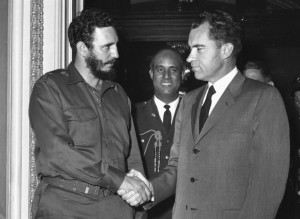
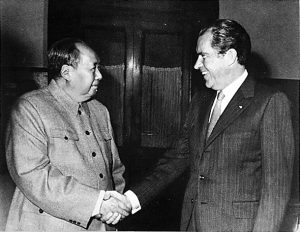 Nixon, serving under Eisenhower, did the dirty in 1959, shaking hands with Fidel Castro, who went on to murderer of as many as 70,000 of his own countrymen. Nixon did it again in the seventies, shaking the hand of Mao Zedong, leader of the brutal Chinese regime that killed somewhere between 40-70 million of its own people through a winning combination of starvation, forced labor and executions. (At least Nixon was wearing a different suit.)
Nixon, serving under Eisenhower, did the dirty in 1959, shaking hands with Fidel Castro, who went on to murderer of as many as 70,000 of his own countrymen. Nixon did it again in the seventies, shaking the hand of Mao Zedong, leader of the brutal Chinese regime that killed somewhere between 40-70 million of its own people through a winning combination of starvation, forced labor and executions. (At least Nixon was wearing a different suit.)
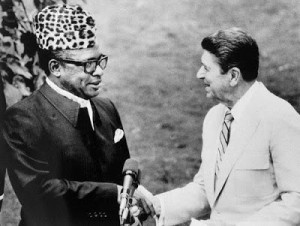 In 1983 President Reagan and the Zairian president Mobutu Sese Seko met, a man who was responsible for many thousands of civilian deaths. The US president praised the despot for giving his political opponents amnesty. Mobutu thanked Reagan back for his support. Much of the world cringed.
In 1983 President Reagan and the Zairian president Mobutu Sese Seko met, a man who was responsible for many thousands of civilian deaths. The US president praised the despot for giving his political opponents amnesty. Mobutu thanked Reagan back for his support. Much of the world cringed.
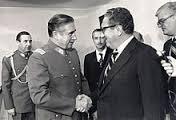 Henry Ford apparently met with the Chilean dictator Pinochet, and Secretary of State Henry Kissinger openly supported the dictator, who was thought to have been at the root of as many as 30,000 deaths. And JFK shook hands with the Sha of Iran in April 1962, a man responsible for the deaths of thousands of innocent Iranian citizens.\
Henry Ford apparently met with the Chilean dictator Pinochet, and Secretary of State Henry Kissinger openly supported the dictator, who was thought to have been at the root of as many as 30,000 deaths. And JFK shook hands with the Sha of Iran in April 1962, a man responsible for the deaths of thousands of innocent Iranian citizens.\
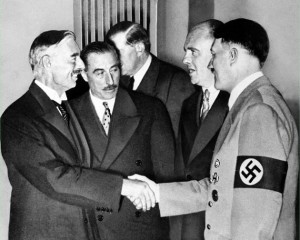 The ill-advised British Prime Minister Neville Chamberlain shook hands with the ultimate dictator and human monster Adolf Hitler in a doomed effort to stop the Second World War happening. And in July 1945 Joseph Stalin, Winston Churchill, and Harry Truman shook hands at Potsdam, Germany, in a meeting to decide how to manage post-war Europe. Stalin was responsible for an awe-inspiringly horrible 30 million deaths.
The ill-advised British Prime Minister Neville Chamberlain shook hands with the ultimate dictator and human monster Adolf Hitler in a doomed effort to stop the Second World War happening. And in July 1945 Joseph Stalin, Winston Churchill, and Harry Truman shook hands at Potsdam, Germany, in a meeting to decide how to manage post-war Europe. Stalin was responsible for an awe-inspiringly horrible 30 million deaths.
Jimmy Carter shook hands with Palestine’s Yasser Arafat as well as the Egyptian leader, Anwar Sadat. In 1977 Carter also shook the hand of the then Shah of Iran, describing the leader as an ‘island of stability’.
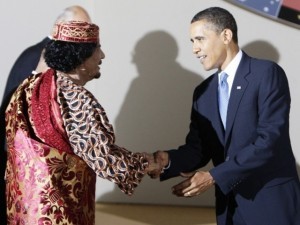 In the year 2000, the Camp David Summit saw Bill Clinton, Israeli prime minister Ehud Barak and Palestinian leader chairman Yasser Arafat shake hands. Donald Rumsfeld and Saddam Hussein have shaken hands. And Obama shook hands with Gaddafi at a G8 dinner in in 2009.
In the year 2000, the Camp David Summit saw Bill Clinton, Israeli prime minister Ehud Barak and Palestinian leader chairman Yasser Arafat shake hands. Donald Rumsfeld and Saddam Hussein have shaken hands. And Obama shook hands with Gaddafi at a G8 dinner in in 2009.
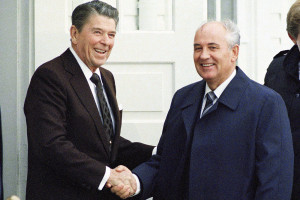 November 19th 1985 saw a legendary shake between President Reagan and the Soviet leader Mikhail Gorbachev, marking the first meeting of the nations’ leaders for six years. And in February 2016 Mr Obama hosted a gang of south east Asian dictators in Southern California, including leaders of repressive regimes Hun Sen from Cambodia, Prayuth Chan-ocha from Thailand, Najib Razak from Malaysia, Hassanal Bolkiah from Brunei, Thein Sein from Myanmar, Choummaly Sayasone from Laos and Nguyen Tan Dung from Vietnam. No doubt he shook hands with them all. And President George H. W. Bush was photographed with a giant-size photo of Mao Tse-tung.
November 19th 1985 saw a legendary shake between President Reagan and the Soviet leader Mikhail Gorbachev, marking the first meeting of the nations’ leaders for six years. And in February 2016 Mr Obama hosted a gang of south east Asian dictators in Southern California, including leaders of repressive regimes Hun Sen from Cambodia, Prayuth Chan-ocha from Thailand, Najib Razak from Malaysia, Hassanal Bolkiah from Brunei, Thein Sein from Myanmar, Choummaly Sayasone from Laos and Nguyen Tan Dung from Vietnam. No doubt he shook hands with them all. And President George H. W. Bush was photographed with a giant-size photo of Mao Tse-tung.
It’s funny how powerful a handshake is and how much offense it causes .
The post Putting things in perspective – Barack and Che appeared first on .



